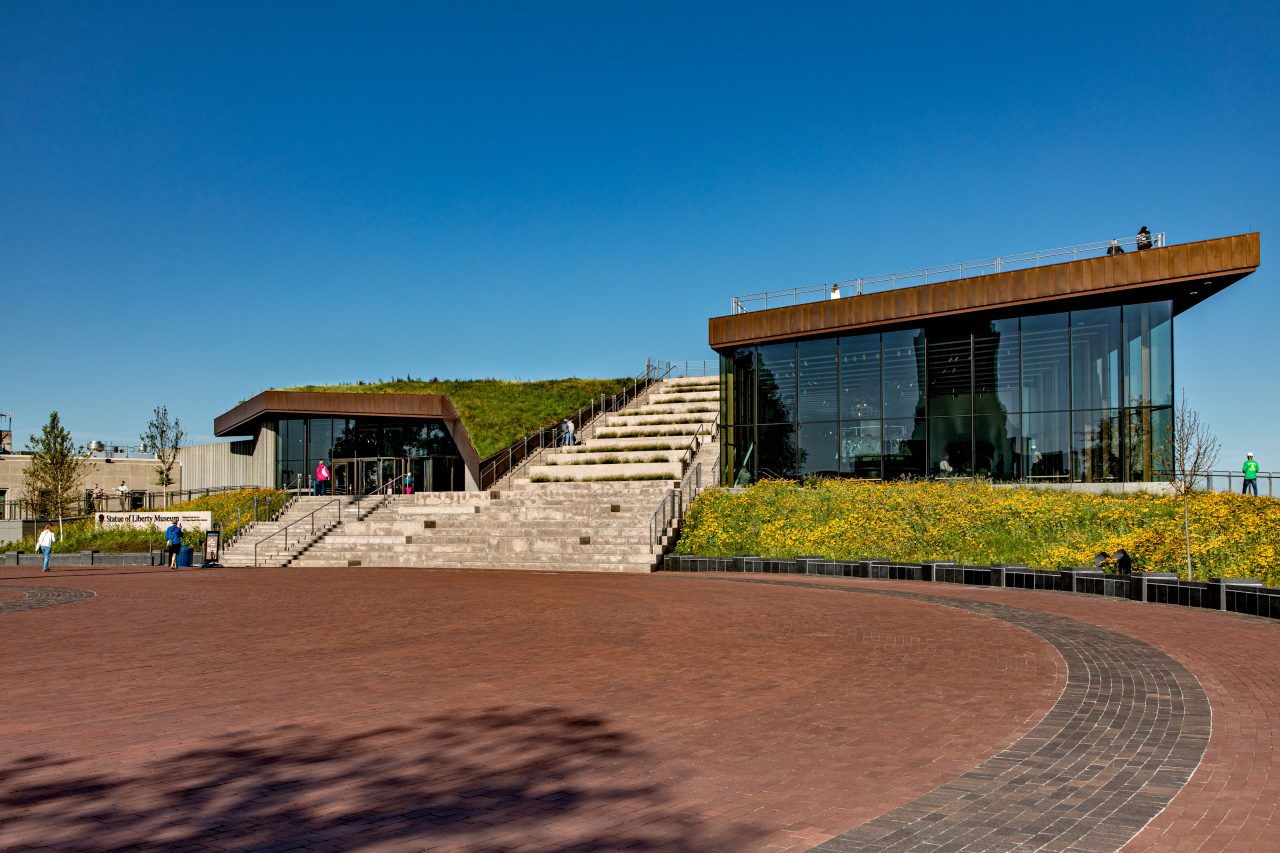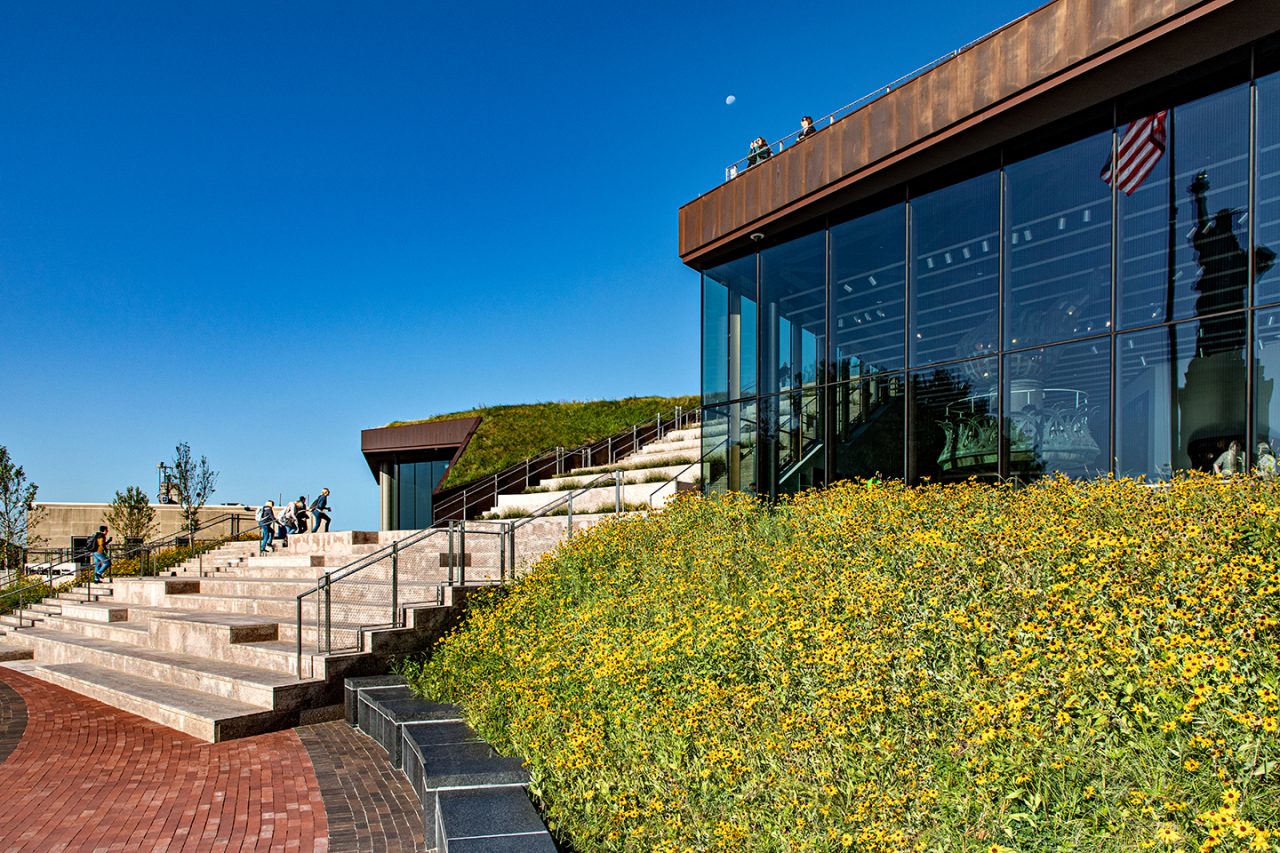Fall 2020

Collaboration
Collaboration is a key ingredient in the making of a successful landscape project. Working with architects, engineers, lighting designers, and artists, we landscape architects rarely engage in a project without the support and input of a number of related professional collaborators. Our belief that the blending of various perspectives elevates and improves both creativity and project understanding has informed many of our most notable projects and provided us with decades-long professional associations and a body of complex projects that blur the line between hard and land scape, technical feat, and art.
Recently, Mark Bunnell, Partner, completed work on the Statue of Liberty Museum landscape with FXCollaborative. The project was described as a “seamless marriage of architecture and landscape,” and was successful as it resulted in a resilient and uplifting experience for the Liberty Island visitors. FXCollaborative encouraged collaboration from the start – welcoming Mark’s ideas for the landscape. The architects envisioned a garden pavilion that appears to emerge from the landscape and rise 10’ above the ground, bringing the landscape with it onto a green roof terrace. A previous schematic plan for the landscape viewed the stepped landscape and faceted green roof areas as distinct landscape zones. Mark, who is known for his ability to solve complex technical problems with elegant solutions, saw an opportunity to make a stronger statement by proposing a single unified landscape expression. He would apply a native meadow and grassland treatment on the entire roof to merge the ground plane and roof top, conjure the imagery of an American landscape and provide an ever-changing tapestry that would respond well to the site conditions and act as a softening counterpoint to the building geometry.

Technical Innovation
Deceptively simple in appearance, the creation of the meadow landscape involved overcoming enormous challenges. Integration of the building to the island’s mall, providing stability and seamless transition between various building elevations and steeply sloping roof planes and the application of a single landscape typology across a variety of site conditions (on grade and on structure, differing wind and sun exposures, and variations in water availability) all presented difficult physical, technical, and ecological demands and opportunities.
Treating the museum’s green roof as an extension of the meadow landscape helped integrate the building with the surrounding landscape. To achieve the effect that the building was lifted out from the meadow required solving a few technical challenges. Typical green roofs feature a wide gravel border around the edge, which would have ruined the eloquence of the gesture. QRP worked closely with FX architects on an edge detail that allowed meadow planting to extend to within four inches of the fascia, separated only by a relatively invisible drainage channel. A continuous band of reinforced planted paver blocks embedded below the meadow surface anchors the drainage medium.

Having witnessed Hurricane Sandy’s damage to green roofs elsewhere in the City, Mark and Project Manager Rucha Mandlik were determined to find an effective solution to the scouring effect that New York Harbor winds posed to the plants. After consulting with Chris Brunner of New York Green Roofs, they settled on an approach using polypropylene netting over the entire roof with extra anchoring around the perimeter, combined with a heavy hydromulch layer to lock in the soil medium.
Another imperative was ensuring enough rooting depth for meadow species. In too many green roof projects, soil depth is one of the first items squeezed in value engineering. But FXCollaborative was fully on board with the need for healthy rooting depth, helping QRP get a full 8” depth of soil medium baked into the structural design of the building.
The most visible part of the roof happened to also be the most challenging for stabilization. Where a triangular facet of the roof folds down steeply near the building entrance, a special waffle system was embedded the full 8 inches to hold the soil medium in place. To prevent over-concentration of moisture at the bottom, successive bands of drip irrigation were incrementally reduced, maintaining a relatively consistent mesic condition over the whole triangular panel. Invisible at the surface but critically important, a custom-designed drain wicks away any excess moisture before it can cascade over the building entrance.

Ecological Artistry
Arriving at a seed palette for the meadow provided another opportunity for collaboration. From the outset, Mark and Rucha wanted to use exclusively native materials to support the harbor ecosystem. Everything had to tolerate salt spray. Plant growth heights needed to align with security surveillance measures. No toxic plants could be used in case of accidental ingestion. Plants requiring deep rooting could not be used on the roof. The desired visual effect was a balance of wavy grasses and flowering species. And all plants needed to be able to accommodate a range of slope and exposure conditions. QRP developed a detailed planting plan combining container plants, plugs and seeding. But it quickly became apparent the cost for the 2/3rd acre roof and approach meadow would drain away a large portion of the funds marked for museum exhibits. So Mark and Rucha approached Neil Diboll, Consulting Ecologist with Prairie Nursery to brainstorm about seed mixes that would thrive in the varying conditions, meet all the design criteria and work within the budget. Neil had consulted for QRP on successful planting projects at Sarah Lawrence College, Green-wood Cemetery and elsewhere, and thankfully agreed. What he may not have foreseen was the need for five different seed mixes to handle all the site conditions: roof, irrigated meadow, non-irrigated meadow, bioretention basin, and irrigated meadow under shady building overhangs. Though differing in makeup, the mixes share enough similar species to appear continuous.

For the roof meadow Rucha and Neil proposed a seed mix of Little Bluestem, Tufted Hairgrass, Fox Sedge, and Woolgrass to create an overall matrix of wavy grasses, along with Wild Columbine, Smooth Aster, and Yellow Wild Indigo to add color and texture notes. Mark liked the idea of the uniform mix responding organically and flexibly to each condition. To quickly stabilize the roof while some of those slower-developing seeds established, they also included Oat Grass as a cover crop. To further ensure quick seed establishment, QRP worked out a dual irrigation approach in consultation with frequent collaborator, Mike Astram of Northern Designs: a drip system embedded just below the netting, plus a separate sacrificial spray system. Covering both the roof and the entire site area, the sacrificial system will be decommissioned after the first year, in compliance with LEED criteria for water efficiency.
Grounding the meadow planting at the plaza level, Paperbark Birches frame the building entrance, while other areas are peppered with Swamp White Oak, Tupelo, and other native trees that stabilize the soil and provide some relief from wind. But Mark and Rucha were glad to have the meadow character prevail, one that visitors could perhaps connect with the country’s heartland, but also a landscape with a solidly enduring sustainability.

A Lasting Impression
In the months since the park has opened, the site has received numerous awards and acclaim. QRP has been back to monitor plant growth noting the effect of site exposure on the various seed mixes. The mix has allowed the best adapted plants for a given exposure to assume localized species dominance of the mix providing a constantly shifting experience of grasses and flowers around the site. It is satisfying to see the vision come to life, but the most gratifying result of this collaboration can be seen as we disembark from the ferry and join the procession through the landscape to the museum rooftop with visitors from all over the world. Watching them interact with the grasslands and meadows as they exclaim, touch and photograph plants on their journey to the singular views of Lady Liberty and the harbor we are humbled as we realize that our landscape has become part of the visual memory of a visit to this iconic American symbol for generations to come.

Images © Barrett Doherty.